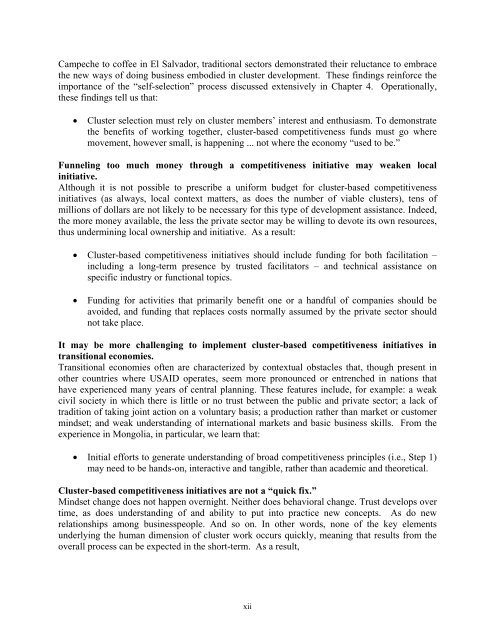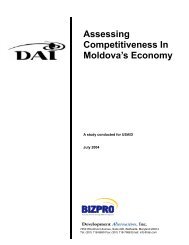Promoting Competitiveness in Practice - Economic Growth - usaid
Promoting Competitiveness in Practice - Economic Growth - usaid
Promoting Competitiveness in Practice - Economic Growth - usaid
You also want an ePaper? Increase the reach of your titles
YUMPU automatically turns print PDFs into web optimized ePapers that Google loves.
Campeche to coffee <strong>in</strong> El Salvador, traditional sectors demonstrated their reluctance to embrace<br />
the new ways of do<strong>in</strong>g bus<strong>in</strong>ess embodied <strong>in</strong> cluster development. These f<strong>in</strong>d<strong>in</strong>gs re<strong>in</strong>force the<br />
importance of the “self-selection” process discussed extensively <strong>in</strong> Chapter 4. Operationally,<br />
these f<strong>in</strong>d<strong>in</strong>gs tell us that:<br />
• Cluster selection must rely on cluster members’ <strong>in</strong>terest and enthusiasm. To demonstrate<br />
the benefits of work<strong>in</strong>g together, cluster-based competitiveness funds must go where<br />
movement, however small, is happen<strong>in</strong>g ... not where the economy “used to be.”<br />
Funnel<strong>in</strong>g too much money through a competitiveness <strong>in</strong>itiative may weaken local<br />
<strong>in</strong>itiative.<br />
Although it is not possible to prescribe a uniform budget for cluster-based competitiveness<br />
<strong>in</strong>itiatives (as always, local context matters, as does the number of viable clusters), tens of<br />
millions of dollars are not likely to be necessary for this type of development assistance. Indeed,<br />
the more money available, the less the private sector may be will<strong>in</strong>g to devote its own resources,<br />
thus underm<strong>in</strong><strong>in</strong>g local ownership and <strong>in</strong>itiative. As a result:<br />
• Cluster-based competitiveness <strong>in</strong>itiatives should <strong>in</strong>clude fund<strong>in</strong>g for both facilitation –<br />
<strong>in</strong>clud<strong>in</strong>g a long-term presence by trusted facilitators – and technical assistance on<br />
specific <strong>in</strong>dustry or functional topics.<br />
• Fund<strong>in</strong>g for activities that primarily benefit one or a handful of companies should be<br />
avoided, and fund<strong>in</strong>g that replaces costs normally assumed by the private sector should<br />
not take place.<br />
It may be more challeng<strong>in</strong>g to implement cluster-based competitiveness <strong>in</strong>itiatives <strong>in</strong><br />
transitional economies.<br />
Transitional economies often are characterized by contextual obstacles that, though present <strong>in</strong><br />
other countries where USAID operates, seem more pronounced or entrenched <strong>in</strong> nations that<br />
have experienced many years of central plann<strong>in</strong>g. These features <strong>in</strong>clude, for example: a weak<br />
civil society <strong>in</strong> which there is little or no trust between the public and private sector; a lack of<br />
tradition of tak<strong>in</strong>g jo<strong>in</strong>t action on a voluntary basis; a production rather than market or customer<br />
m<strong>in</strong>dset; and weak understand<strong>in</strong>g of <strong>in</strong>ternational markets and basic bus<strong>in</strong>ess skills. From the<br />
experience <strong>in</strong> Mongolia, <strong>in</strong> particular, we learn that:<br />
• Initial efforts to generate understand<strong>in</strong>g of broad competitiveness pr<strong>in</strong>ciples (i.e., Step 1)<br />
may need to be hands-on, <strong>in</strong>teractive and tangible, rather than academic and theoretical.<br />
Cluster-based competitiveness <strong>in</strong>itiatives are not a “quick fix.”<br />
M<strong>in</strong>dset change does not happen overnight. Neither does behavioral change. Trust develops over<br />
time, as does understand<strong>in</strong>g of and ability to put <strong>in</strong>to practice new concepts. As do new<br />
relationships among bus<strong>in</strong>esspeople. And so on. In other words, none of the key elements<br />
underly<strong>in</strong>g the human dimension of cluster work occurs quickly, mean<strong>in</strong>g that results from the<br />
overall process can be expected <strong>in</strong> the short-term. As a result,<br />
xii
















